2008 NISSAN TEANA window
[x] Cancel search: windowPage 3635 of 5121
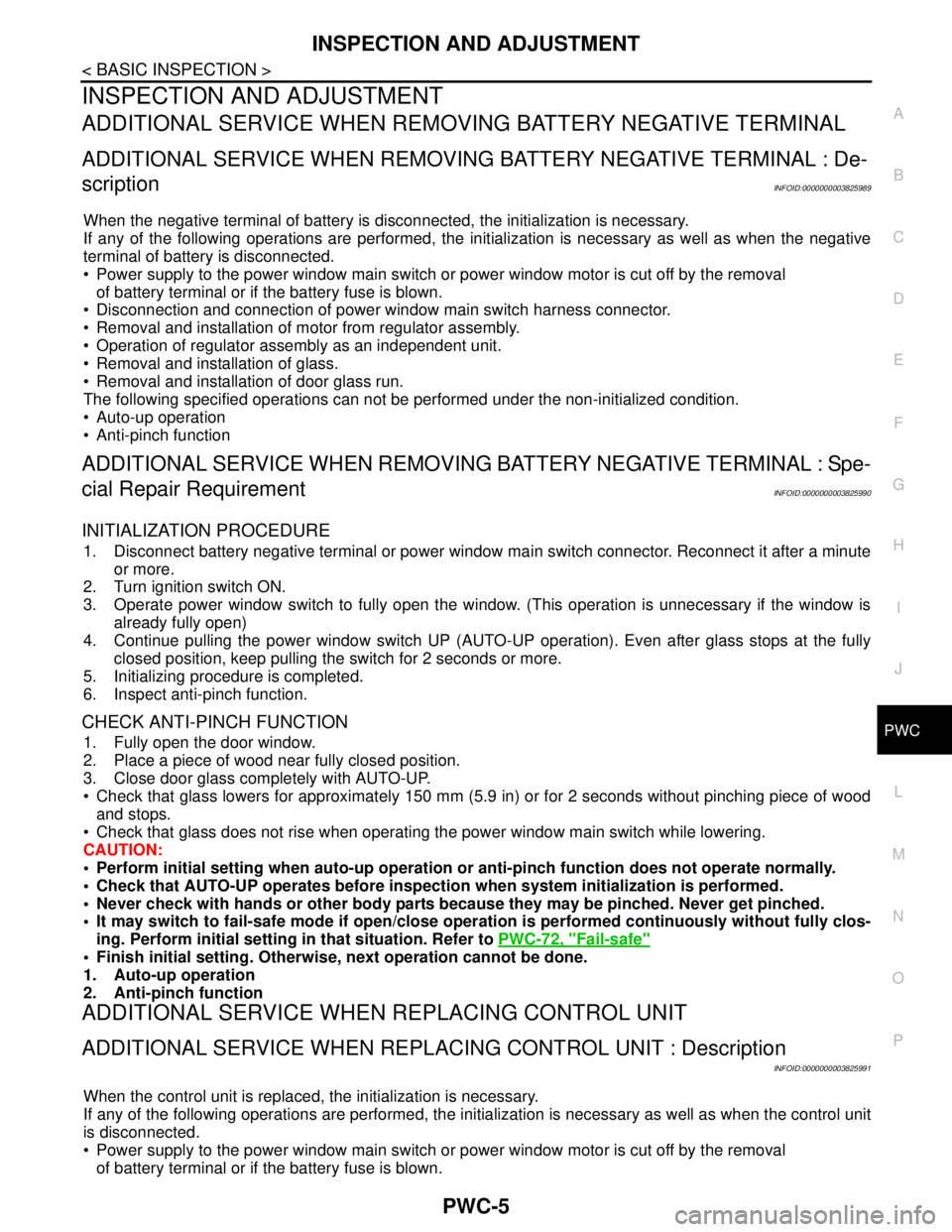
INSPECTION AND ADJUSTMENT
PWC-5
< BASIC INSPECTION >
C
D
E
F
G
H
I
J
L
MA
B
PWC
N
O
P
INSPECTION AND ADJUSTMENT
ADDITIONAL SERVICE WHEN REMOVING BATTERY NEGATIVE TERMINAL
ADDITIONAL SERVICE WHEN REMOVING BATTERY NEGATIVE TERMINAL : De-
scription
INFOID:0000000003825989
When the negative terminal of battery is disconnected, the initialization is necessary.
If any of the following operations are performed, the initialization is necessary as well as when the negative
terminal of battery is disconnected.
Power supply to the power window main switch or power window motor is cut off by the removal
of battery terminal or if the battery fuse is blown.
Disconnection and connection of power window main switch harness connector.
Removal and installation of motor from regulator assembly.
Operation of regulator assembly as an independent unit.
Removal and installation of glass.
Removal and installation of door glass run.
The following specified operations can not be performed under the non-initialized condition.
Auto-up operation
Anti-pinch function
ADDITIONAL SERVICE WHEN REMOVING BATTERY NEGATIVE TERMINAL : Spe-
cial Repair Requirement
INFOID:0000000003825990
INITIALIZATION PROCEDURE
1. Disconnect battery negative terminal or power window main switch connector. Reconnect it after a minute
or more.
2. Turn ignition switch ON.
3. Operate power window switch to fully open the window. (This operation is unnecessary if the window is
already fully open)
4. Continue pulling the power window switch UP (AUTO-UP operation). Even after glass stops at the fully
closed position, keep pulling the switch for 2 seconds or more.
5. Initializing procedure is completed.
6. Inspect anti-pinch function.
CHECK ANTI-PINCH FUNCTION
1. Fully open the door window.
2. Place a piece of wood near fully closed position.
3. Close door glass completely with AUTO-UP.
Check that glass lowers for approximately 150 mm (5.9 in) or for 2 seconds without pinching piece of wood
and stops.
Check that glass does not rise when operating the power window main switch while lowering.
CAUTION:
• Perform initial setting when auto-up operation or anti-pinch function does not operate normally.
Check that AUTO-UP operates before inspection when system initialization is performed.
Never check with hands or other body parts because they may be pinched. Never get pinched.
It may switch to fail-safe mode if open/close operation is performed continuously without fully clos-
ing. Perform initial setting in that situation. Refer to PWC-72, "
Fail-safe"
Finish initial setting. Otherwise, next operation cannot be done.
1. Auto-up operation
2. Anti-pinch function
ADDITIONAL SERVICE WHEN REPLACING CONTROL UNIT
ADDITIONAL SERVICE WHEN REPLACING CONTROL UNIT : Description
INFOID:0000000003825991
When the control unit is replaced, the initialization is necessary.
If any of the following operations are performed, the initialization is necessary as well as when the control unit
is disconnected.
Power supply to the power window main switch or power window motor is cut off by the removal
of battery terminal or if the battery fuse is blown.
Page 3636 of 5121
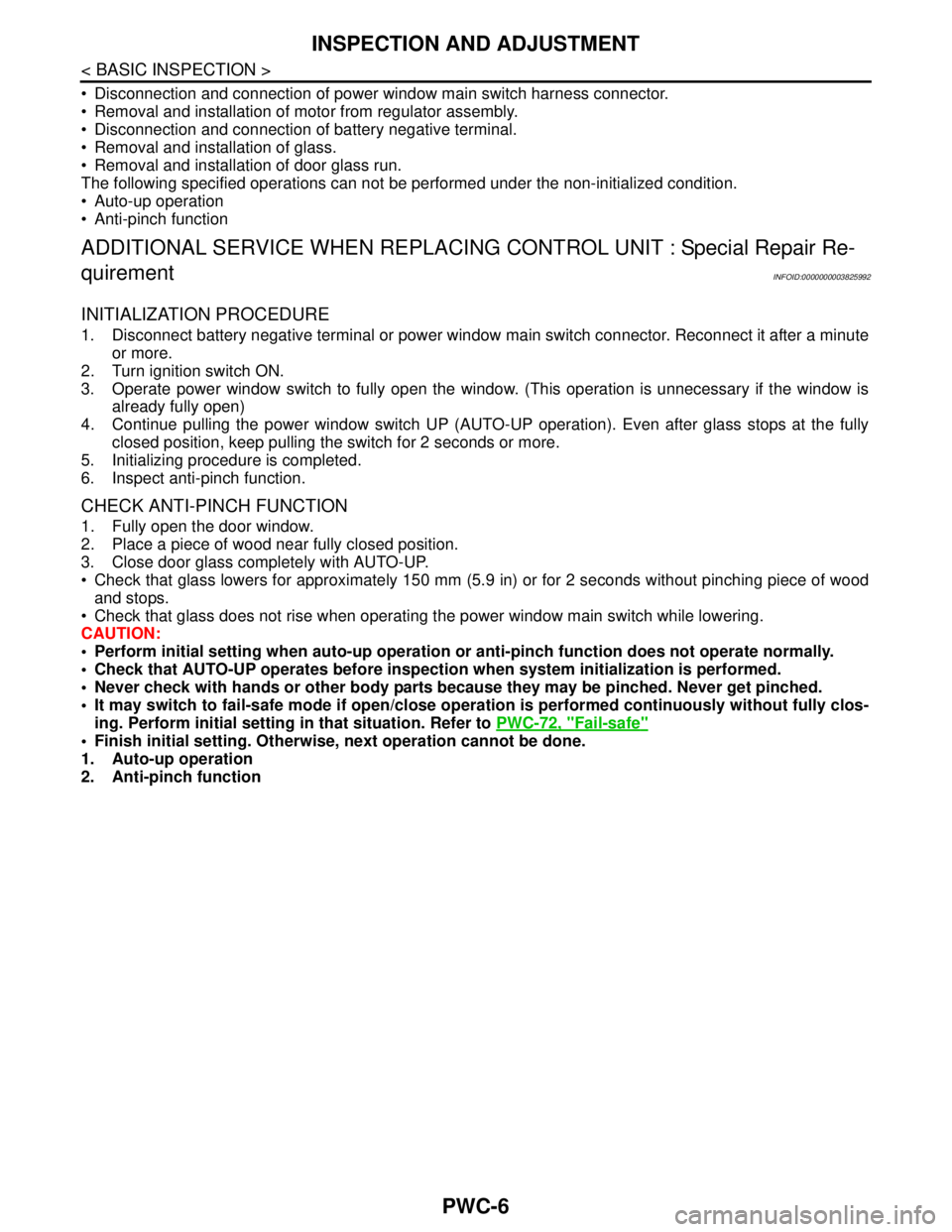
PWC-6
< BASIC INSPECTION >
INSPECTION AND ADJUSTMENT
Disconnection and connection of power window main switch harness connector.
Removal and installation of motor from regulator assembly.
Disconnection and connection of battery negative terminal.
Removal and installation of glass.
Removal and installation of door glass run.
The following specified operations can not be performed under the non-initialized condition.
Auto-up operation
Anti-pinch function
ADDITIONAL SERVICE WHEN REPLACING CONTROL UNIT : Special Repair Re-
quirement
INFOID:0000000003825992
INITIALIZATION PROCEDURE
1. Disconnect battery negative terminal or power window main switch connector. Reconnect it after a minute
or more.
2. Turn ignition switch ON.
3. Operate power window switch to fully open the window. (This operation is unnecessary if the window is
already fully open)
4. Continue pulling the power window switch UP (AUTO-UP operation). Even after glass stops at the fully
closed position, keep pulling the switch for 2 seconds or more.
5. Initializing procedure is completed.
6. Inspect anti-pinch function.
CHECK ANTI-PINCH FUNCTION
1. Fully open the door window.
2. Place a piece of wood near fully closed position.
3. Close door glass completely with AUTO-UP.
Check that glass lowers for approximately 150 mm (5.9 in) or for 2 seconds without pinching piece of wood
and stops.
Check that glass does not rise when operating the power window main switch while lowering.
CAUTION:
Perform initial setting when auto-up operation or anti-pinch function does not operate normally.
Check that AUTO-UP operates before inspection when system initialization is performed.
Never check with hands or other body parts because they may be pinched. Never get pinched.
It may switch to fail-safe mode if open/close operation is performed continuously without fully clos-
ing. Perform initial setting in that situation. Refer to PWC-72, "
Fail-safe"
Finish initial setting. Otherwise, next operation cannot be done.
1. Auto-up operation
2. Anti-pinch function
Page 3637 of 5121
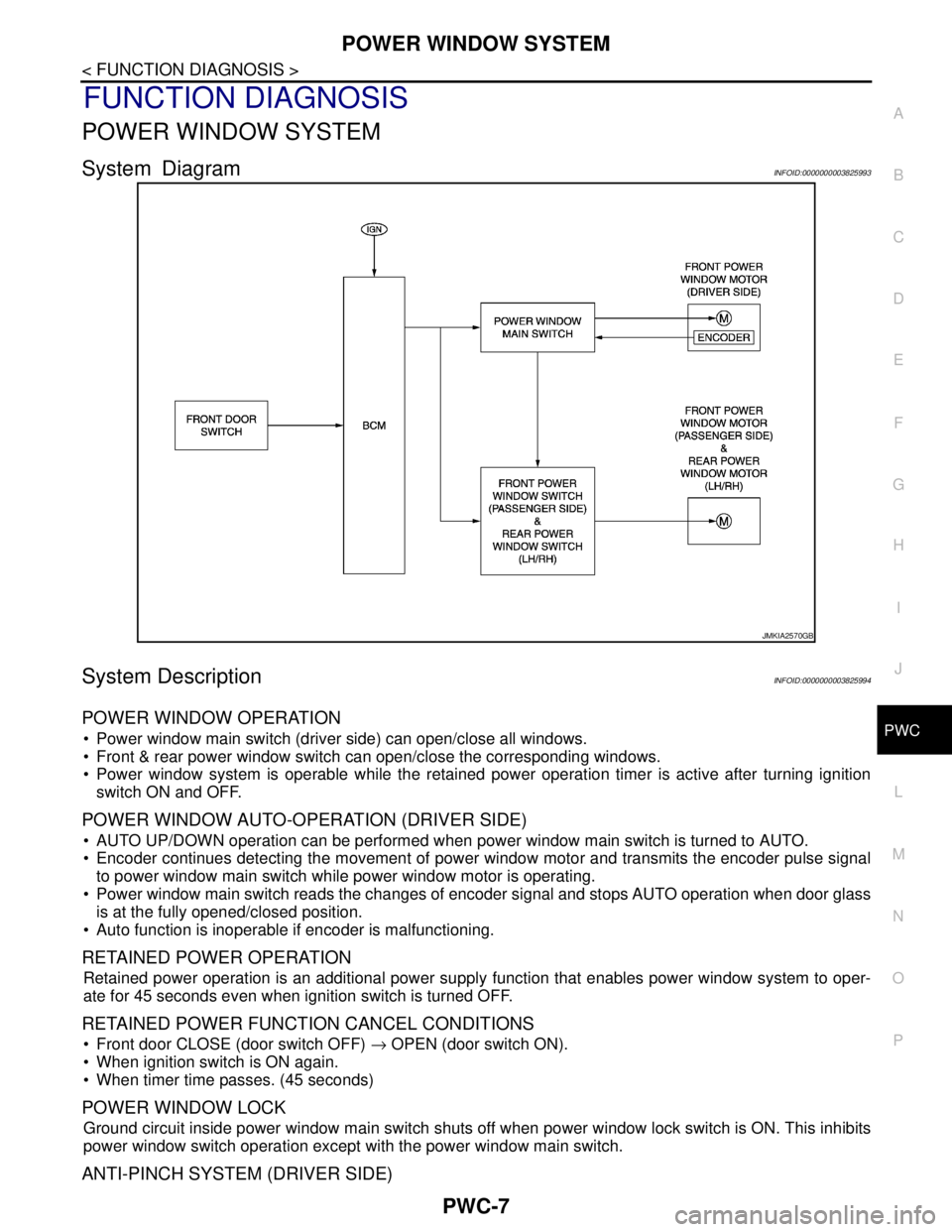
POWER WINDOW SYSTEM
PWC-7
< FUNCTION DIAGNOSIS >
C
D
E
F
G
H
I
J
L
MA
B
PWC
N
O
P
FUNCTION DIAGNOSIS
POWER WINDOW SYSTEM
System DiagramINFOID:0000000003825993
System DescriptionINFOID:0000000003825994
POWER WINDOW OPERATION
Power window main switch (driver side) can open/close all windows.
Front & rear power window switch can open/close the corresponding windows.
Power window system is operable while the retained power operation timer is active after turning ignition
switch ON and OFF.
POWER WINDOW AUTO-OPERATION (DRIVER SIDE)
AUTO UP/DOWN operation can be performed when power window main switch is turned to AUTO.
Encoder continues detecting the movement of power window motor and transmits the encoder pulse signal
to power window main switch while power window motor is operating.
Power window main switch reads the changes of encoder signal and stops AUTO operation when door glass
is at the fully opened/closed position.
Auto function is inoperable if encoder is malfunctioning.
RETAINED POWER OPERATION
Retained power operation is an additional power supply function that enables power window system to oper-
ate for 45 seconds even when ignition switch is turned OFF.
RETAINED POWER FUNCTION CANCEL CONDITIONS
Front door CLOSE (door switch OFF) → OPEN (door switch ON).
When ignition switch is ON again.
When timer time passes. (45 seconds)
POWER WINDOW LOCK
Ground circuit inside power window main switch shuts off when power window lock switch is ON. This inhibits
power window switch operation except with the power window main switch.
ANTI-PINCH SYSTEM (DRIVER SIDE)
JMKIA2570GB
Page 3638 of 5121
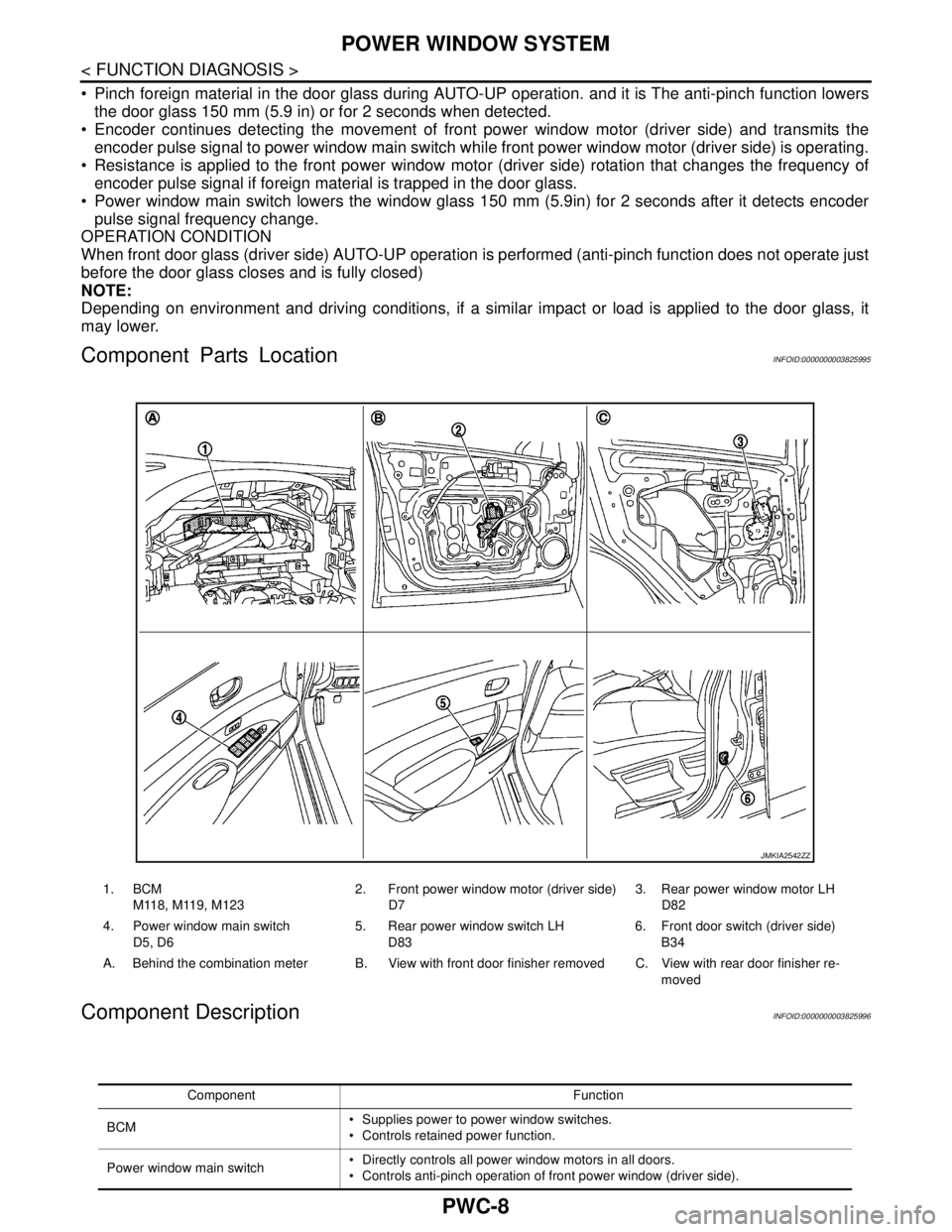
PWC-8
< FUNCTION DIAGNOSIS >
POWER WINDOW SYSTEM
Pinch foreign material in the door glass during AUTO-UP operation. and it is The anti-pinch function lowers
the door glass 150 mm (5.9 in) or for 2 seconds when detected.
Encoder continues detecting the movement of front power window motor (driver side) and transmits the
encoder pulse signal to power window main switch while front power window motor (driver side) is operating.
Resistance is applied to the front power window motor (driver side) rotation that changes the frequency of
encoder pulse signal if foreign material is trapped in the door glass.
Power window main switch lowers the window glass 150 mm (5.9in) for 2 seconds after it detects encoder
pulse signal frequency change.
OPERATION CONDITION
When front door glass (driver side) AUTO-UP operation is performed (anti-pinch function does not operate just
before the door glass closes and is fully closed)
NOTE:
Depending on environment and driving conditions, if a similar impact or load is applied to the door glass, it
may lower.
Component Parts LocationINFOID:0000000003825995
Component DescriptionINFOID:0000000003825996
1. BCM
M118, M119, M1232. Front power window motor (driver side)
D73. Rear power window motor LH
D82
4. Power window main switch
D5, D65. Rear power window switch LH
D836. Front door switch (driver side)
B34
A. Behind the combination meter B. View with front door finisher removed C. View with rear door finisher re-
moved
JMKIA2542ZZ
Component Function
BCM Supplies power to power window switches.
Controls retained power function.
Power window main switch Directly controls all power window motors in all doors.
Controls anti-pinch operation of front power window (driver side).
Page 3639 of 5121

POWER WINDOW SYSTEM
PWC-9
< FUNCTION DIAGNOSIS >
C
D
E
F
G
H
I
J
L
MA
B
PWC
N
O
P
Front power window switch (passenger
side)Controls power window motor of front passenger side door.
Rear power window switch (LH & RH) Controls power window motor of rear right and left doors.
Front power window motor (driver side) Integrates the encoder and power window motor.
Starts operating with signals from power window main switch.
Transmits front power window motor (driver side) rotation as a pulse signal to power
window main switch.
Front power window motor (passenger
side)Starts operating with signals from power window main switch & front power window
switch (passenger side).
Rear power window motor (LH & RH)Starts operating with signals from power window main switch & rear power window
switch (LH & RH).
Front door switch (driver side & passen-
ger side)Detects door open/close condition and input to BCM. Component Function
Page 3640 of 5121

PWC-10
< FUNCTION DIAGNOSIS >
DIAGNOSIS SYSTEM (BCM)
DIAGNOSIS SYSTEM (BCM)
COMMON ITEM
COMMON ITEM : CONSULT-III Function (BCM - COMMON ITEM)INFOID:0000000003825997
APPLICATION ITEM
CONSULT-III performs the following functions via CAN communication with BCM.
SYSTEM APPLICATION
BCM can perform the following functions for each system.
NOTE:
It can perform the diagnosis modes except the following for all sub system selection items.
×: Applicable item
NOTE:
*: This item is displayed, but is not used.
FREEZE FRAME DATA (FFD) AND IGN COUNTER
Freeze Frame Data
Diagnosis mode Function Description
Work Support Changes the setting for each system function.
Self Diagnostic Result Displays the diagnosis results judged by BCM.
CAN Diag Support MonitorMonitors the reception status of CAN communication viewed from BCM. Refer to CONSULT-III opera-
tion manual.
Data Monitor The BCM input/output signals are displayed.
Active Test The signals used to activate each device are forcibly supplied from BCM.
Ecu Identification The BCM part number is displayed.
Configuration Read and save the vehicle specification.
Write the vehicle specification when replacing BCM.
System Sub system selection itemDiagnosis mode
Work Support Data Monitor Active Test
Door lock DOOR LOCK×××
Rear window defogger REAR DEFOGGER××
Warning chime BUZZER××
Interior room lamp timer INT LAMP×××
Exterior lamp HEAD LAMP×××
Wiper and washer WIPER××
Turn signal and hazard warning lamps FLASHER×××
— AIR CONDITONER*
Intelligent Key system
Engine start systemINTELLIGENT KEY×××
Combination switch COMB SW×
Body control system BCM×
IVIS - NATS IMMU××
Interior room lamp battery saver BATTERY SAVER×××
Back door open TRUNK××
Vehicle security system THEFT ALM×××
— RETAINED PWR*×
Signal buffer system SIGNAL BUFFER××
— TPMS (AIR PRESSURE MONITOR)*×××
Page 3642 of 5121
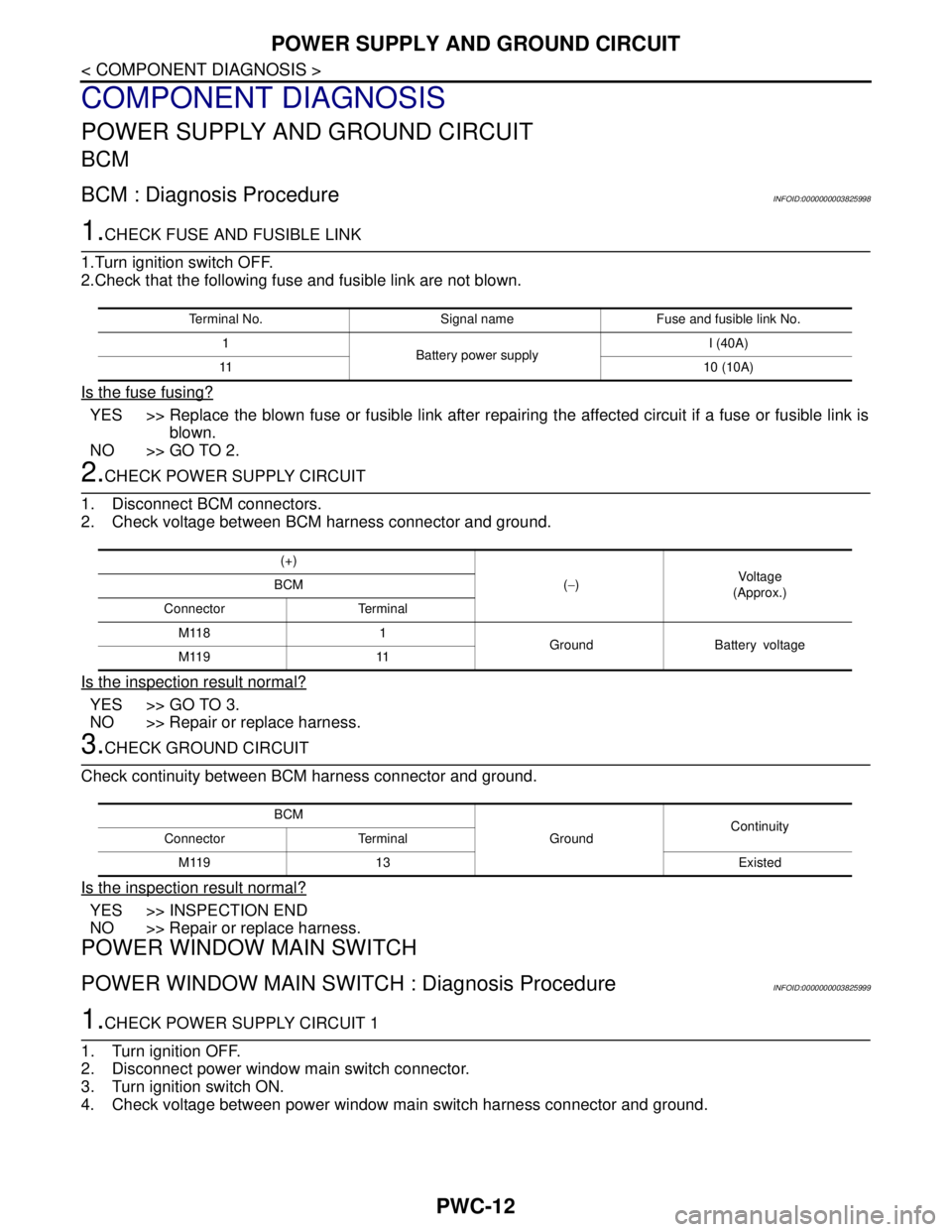
PWC-12
< COMPONENT DIAGNOSIS >
POWER SUPPLY AND GROUND CIRCUIT
COMPONENT DIAGNOSIS
POWER SUPPLY AND GROUND CIRCUIT
BCM
BCM : Diagnosis ProcedureINFOID:0000000003825998
1.CHECK FUSE AND FUSIBLE LINK
1.Turn ignition switch OFF.
2.Check that the following fuse and fusible link are not blown.
Is the fuse fusing?
YES >> Replace the blown fuse or fusible link after repairing the affected circuit if a fuse or fusible link is
blown.
NO >> GO TO 2.
2.CHECK POWER SUPPLY CIRCUIT
1. Disconnect BCM connectors.
2. Check voltage between BCM harness connector and ground.
Is the inspection result normal?
YES >> GO TO 3.
NO >> Repair or replace harness.
3.CHECK GROUND CIRCUIT
Check continuity between BCM harness connector and ground.
Is the inspection result normal?
YES >> INSPECTION END
NO >> Repair or replace harness.
POWER WINDOW MAIN SWITCH
POWER WINDOW MAIN SWITCH : Diagnosis ProcedureINFOID:0000000003825999
1.CHECK POWER SUPPLY CIRCUIT 1
1. Turn ignition OFF.
2. Disconnect power window main switch connector.
3. Turn ignition switch ON.
4. Check voltage between power window main switch harness connector and ground.
Terminal No. Signal name Fuse and fusible link No.
1
Battery power supplyI (40A)
1110 (10A)
(+)
(−)Vo l ta g e
(Approx.) BCM
Connector Terminal
M118 1
Ground Battery voltage
M119 11
BCM
GroundContinuity
Connector Terminal
M119 13 Existed
Page 3643 of 5121
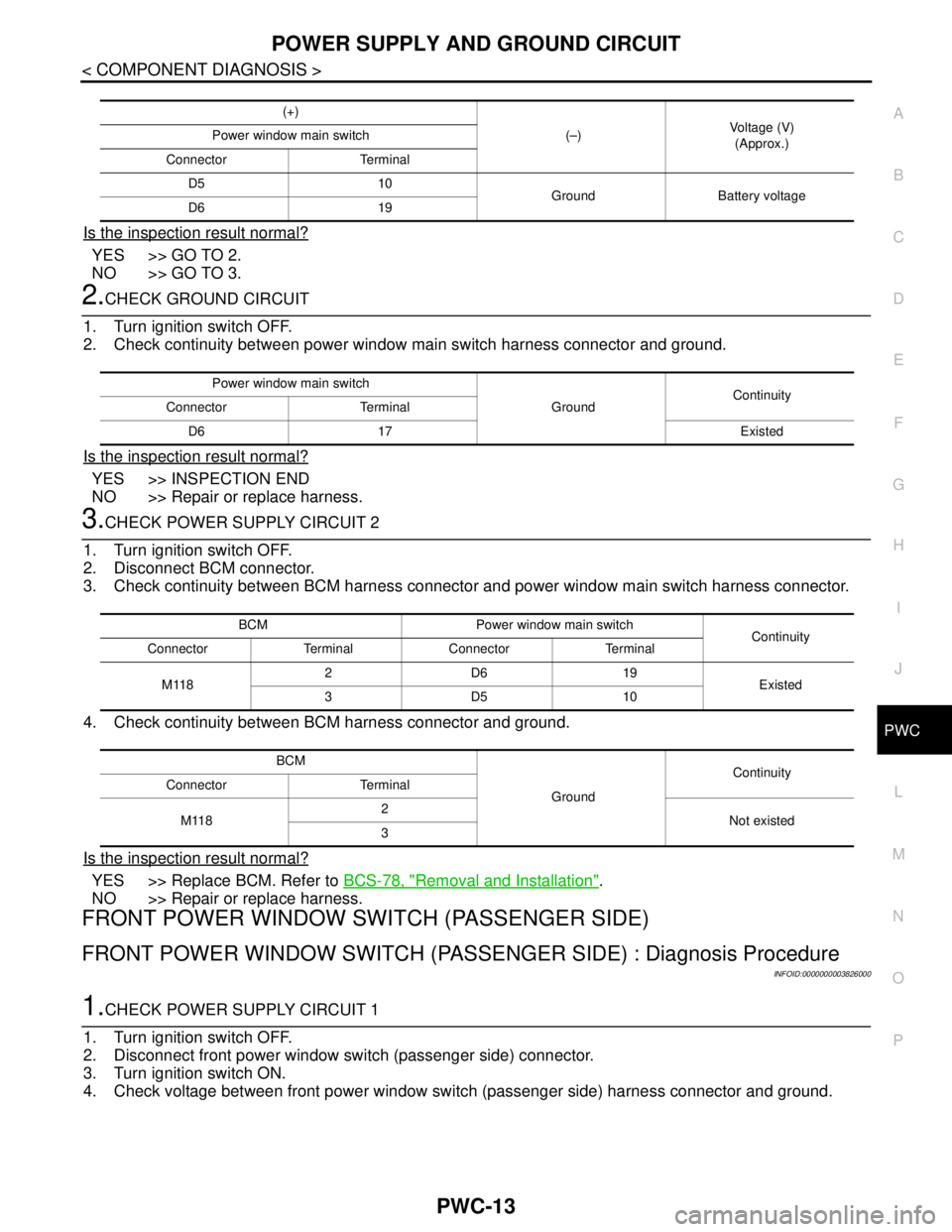
POWER SUPPLY AND GROUND CIRCUIT
PWC-13
< COMPONENT DIAGNOSIS >
C
D
E
F
G
H
I
J
L
MA
B
PWC
N
O
P
Is the inspection result normal?
YES >> GO TO 2.
NO >> GO TO 3.
2.CHECK GROUND CIRCUIT
1. Turn ignition switch OFF.
2. Check continuity between power window main switch harness connector and ground.
Is the inspection result normal?
YES >> INSPECTION END
NO >> Repair or replace harness.
3.CHECK POWER SUPPLY CIRCUIT 2
1. Turn ignition switch OFF.
2. Disconnect BCM connector.
3. Check continuity between BCM harness connector and power window main switch harness connector.
4. Check continuity between BCM harness connector and ground.
Is the inspection result normal?
YES >> Replace BCM. Refer to BCS-78, "Removal and Installation".
NO >> Repair or replace harness.
FRONT POWER WINDOW SWITCH (PASSENGER SIDE)
FRONT POWER WINDOW SWITCH (PASSENGER SIDE) : Diagnosis Procedure
INFOID:0000000003826000
1.CHECK POWER SUPPLY CIRCUIT 1
1. Turn ignition switch OFF.
2. Disconnect front power window switch (passenger side) connector.
3. Turn ignition switch ON.
4. Check voltage between front power window switch (passenger side) harness connector and ground.
(+)
(–)Voltage (V)
(Approx.) Power window main switch
Connector Terminal
D5 10
Ground Battery voltage
D6 19
Power window main switch
GroundContinuity
Connector Terminal
D6 17 Existed
BCM Power window main switch
Continuity
Connector Terminal Connector Terminal
M1182D619
Existed
3D510
BCM
GroundContinuity
Connector Terminal
M1182
Not existed
3